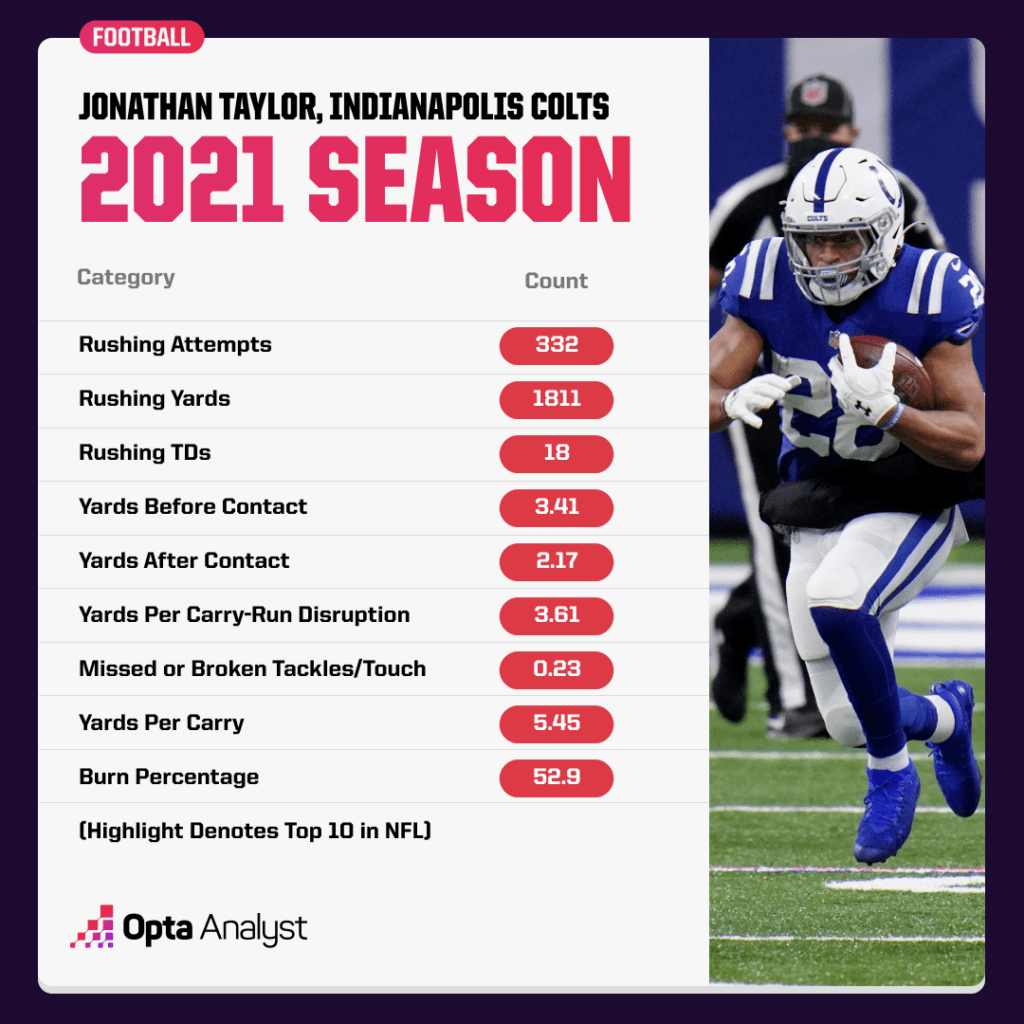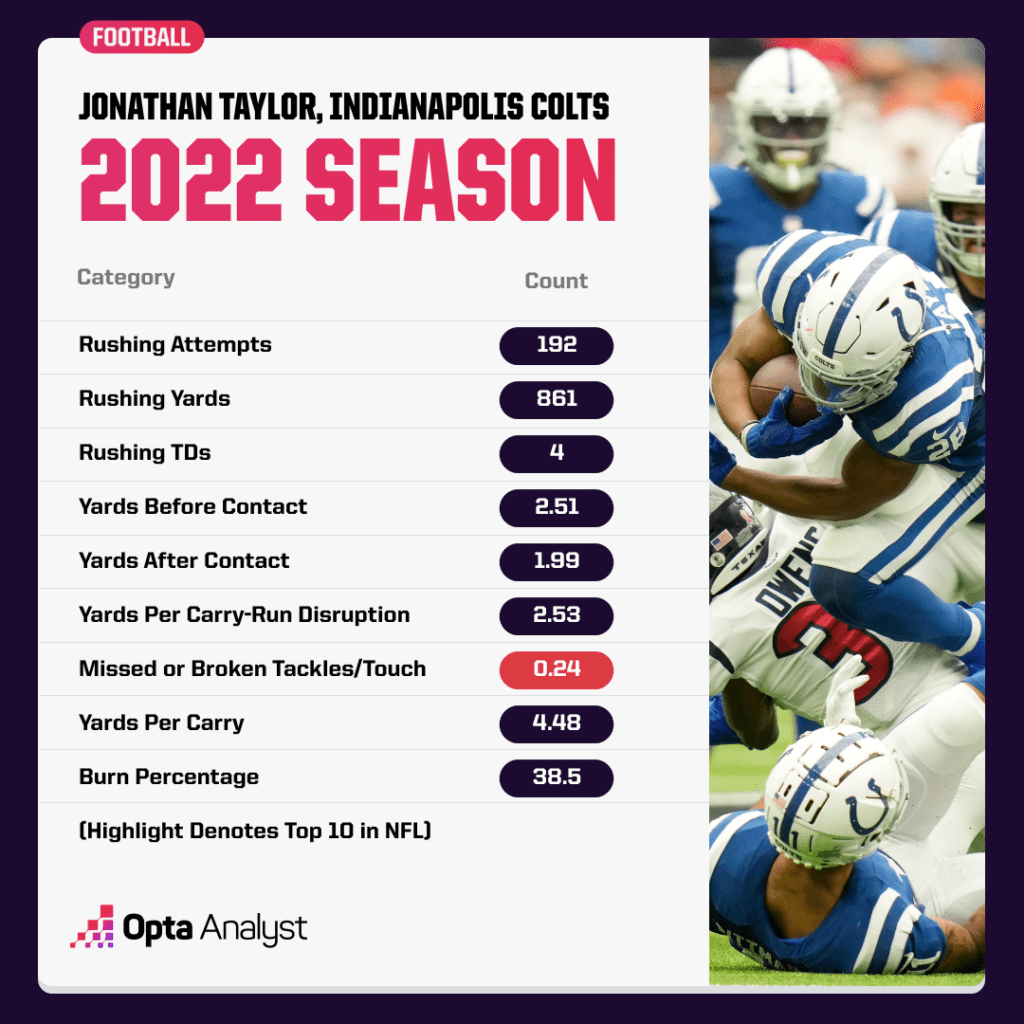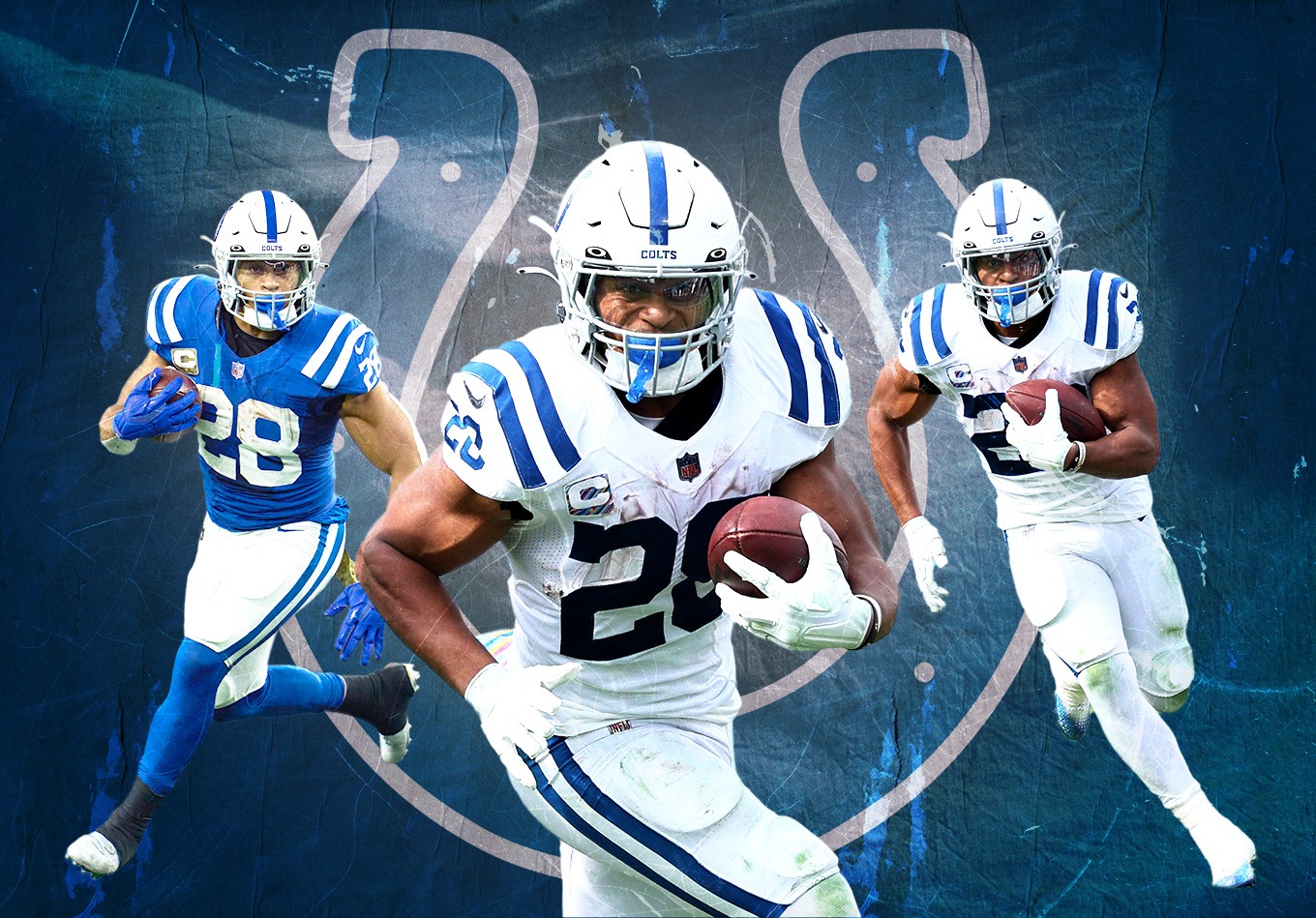The NFL’s most explosive contract dispute of the moment is the one between All-Pro tailback Jonathan Taylor and the Indianapolis Colts.
Taylor is heading into the fourth and final year of a rookie contract he signed before the 2020 season as a second-round draft pick out of Wisconsin. He rapidly became one of the most prolific ball carriers in the NFL, posting a 5.0-yard per-carry average, 1,169 yards, and 11 touchdowns on the ground as a rookie.
The 5-foot-10, 226-pound Taylor ascended to a new plane in 2021, when he led the league with 1,811 rushing yards (a 5.5-yard average) and 2,171 yards from scrimmage, finishing second in the Offensive Player of the Year voting.
Not even two years later, Taylor has asked for a trade, and Colts owner Jim Irsay is publicly reminding people that Taylor could be out of the league tomorrow, Irsay could be dead, and the wheels of the NFL wouldn’t stop spinning. The Colts and Taylor are giving different versions of a story about Taylor’s medical history, and it’s become a stunningly toxic moment in a marriage that looked great until it didn’t. Taylor wants a new deal, the Colts don’t want to give him one now, and what comes next is murky.
Taylor’s 2022 season represented an across-the-board decline from his breakthrough in 2021. NFL teams have become loath to pay running backs under almost any circumstance, and Taylor’s (relative) down year likely encouraged the Colts to be stingy with a man who until recently seemed likely to be a franchise player.
Does Taylor deserve one of the biggest running back contracts in the league now, or are the Colts just doing good business by withholding it? The 2023 campaign will tell the story.
In 2021, Taylor didn’t just put up enormous counting stats. He was an ultra-efficient back who kept the offense on track even when things got dicey around him. Part of the NFL’s reticence toward big running back compensation is a belief that backs are context-dependent players – that a running back’s success or failure depends largely on things out of his control like defensive positioning and blocking. That’s true, to a significant extent, but Taylor gave the theory a run for its money as he busted out.
On runs when one of Taylor’s blockers was beaten cleanly enough for a defender to fill two gaps by himself, Taylor shined. He carried for a 3.61-yard average on plays featuring a run disruption, fifth in the league among those with more than 100 carries and well above the 2.96 league average.

He ranked ninth in the NFL with 2.17 yards after contact, against a league average of 1.95, and what was especially impressive about Taylor was how he kept up those numbers over so much consistent volume. Taylor’s 332 attempts were the most in the league. No skill-position player absorbed more contact on a more regular basis than Taylor, and he was a bear for defenders to bring down when they had the misfortune of catching him.
Taylor was a bear for defenders to bring down when they had the misfortune of catching him. A lot of defenders struggled to even wrap him up, of course. Taylor averaged 0.23 missed or broken tackles per touch. That MBTK/TOU ratio made him one of the slipperiest backs in the league (fifth), again over an avalanche of carries across the season. (73 would-be tacklers just missed Taylor altogether, while he broke 11 and kept running.)
Nobody would ever confuse Taylor with a receiving specialist, but he also proved adept at running routes. His 52.9% burn rate was well above the league average for running backs (47.0%). Taylor’s ability to get away from linebackers and safeties showed up in his 40 catches for another 360 yards and a pair of touchdowns.
Only one other player in the NFL had anything close to Taylor’s overall workload: Steelers rookie Najee Harris, who averaged 4.4 yards on 381 touches. Taylor averaged 5.8 on 372, and to get to a player who averaged more yards per touch, one would have to go down to a player who had just 169 touches: 45% of Taylor’s figure. His combination of efficiency and durability was unparalleled among NFL backs.
Then 2022 happened, and some of the brutal realities of NFL running back play started to set in. Taylor had started all 17 games in 2021, but injuries limited him to 11 this time around. His conventional numbers took a related nosedive: 861 rush yards on a 4.5-yard average, four rushing TDs, and 220 touches overall at a 4.6-yard average. Taylor didn’t earn another Pro Bowl nod, much less make first-team All-Pro or challenge for Offensive Player of the Year honors.
He was suddenly a much more normal tailback. The Colts arguably paved decent lanes for him, as Taylor’s 2.51 yards before contact were a tick above the league average (2.42) for running backs. But that was a far cry from the 3.41 YBCO he enjoyed in 2021, and Taylor struggled as defenses closed in on him more quickly. He averaged 1.99 yards after contact, which was just under the league average YACO (2.04).

On plays with run disruptions, he averaged 2.53 yards, well behind a 2.91-yard NFL average and nearly a full yard behind his 3.61-yard figure from the year before. Defenders were reaching Taylor more quickly, and once they did, he had a harder time shaking them.
The 2022 version of Taylor was similarly a less dangerous route runner, posting a burn percentage of just 38.5 against a league average of 45.8 for tailbacks. He generated a big play, defined as a 20-yard or touchdown-resulting burn of his coverage defender, on just 3.6% of his routes, compared to a 12.6% average for his position.
In most of the areas where Taylor was an exceptional player in 2021, he was normal or worse in 2022. It’s a cruel position and a cruel game.
The current fight between the running back and his team doesn’t concern past performance, though. It deals with what Taylor will be in the future. The specifics of Taylor’s contract demands aren’t clear, but the shape of the running back market suggests that a 24-year-old back who already has a rushing title to his name should want something on the order of $15 million per year, roughly a tripling of the $5.1 million Taylor is making this season on the final year of his rookie deal.
Taylor’s young age is a point in his favor, even with the understanding that running backs peak quickly. Another edge: Even in a much tougher 2022 that saw his production suffer in most ways, Taylor handled a heavy workload and showed glimpses of his former brilliance. And even in a year in which he fought through injuries, Taylor was right around the league average in yards after contact.
The Colts would like to see a rebound before committing big long-term money to Taylor, who is understandably fed up that he hasn’t gotten it already. If the Colts get a great 2023 out of Taylor, that’ll be a huge help to rookie QB Anthony Richardson and a compelling data point as the team decides whether to offer Taylor more money. If Taylor doesn’t have a great 2023, the Colts will have more leverage or feel better about moving on.
It’s a game of chicken, and the deck is stacked against the running back.
Like this? Follow us on Twitter for more.
